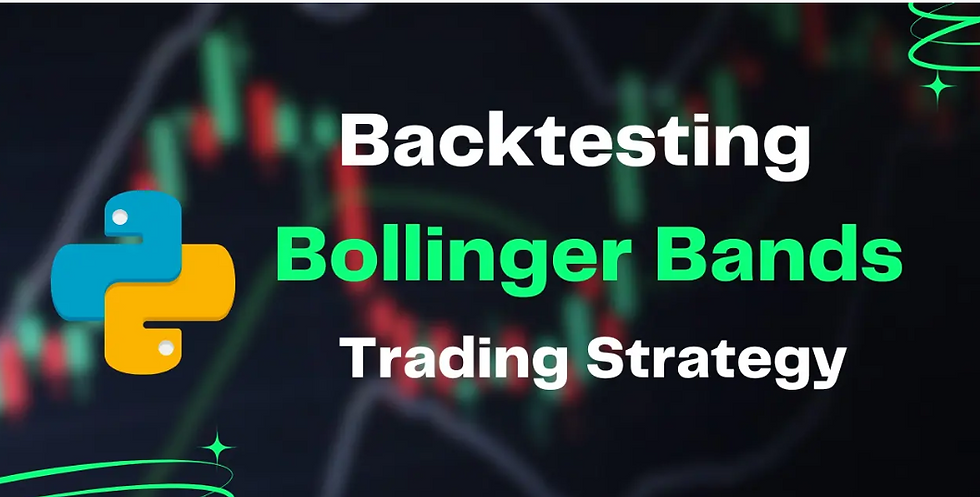How to Implement a Bollinger Band Strategy using Python
- Amman Kumar
- Mar 22
- 4 min read
Trading is all about making smart decisions based on market trends. But how do traders know when prices might rise or fall?
One of the most useful tools for this is Bollinger Bands, which help identify market trends and price changes.
Now, imagine if you could automate this entire process, making your trading faster and easier. That’s where Python comes in. With simple coding, you can fetch stock data, calculate Bollinger Bands, visualize price trends, and even create automatic trade signals—all without doing it manually every time.
In this article, we’ll explain Bollinger Bands in a simple way, show you how to use them in Python, and guide you through building an easy trading strategy.
Whether you’re just starting or have some experience, by the end of this guide, you’ll know how to use Python to improve your trading decisions. Let’s get started! 🚀
What Are Bollinger Bands

Bollinger Band are a technical indicator developed by John Bollinger that helps traders understand price movements and market volatility. They are made up of three main lines:
The Three Components of Bollinger Bands
Middle Band
This is a Simple Moving Average (SMA), usually set to 20 periods. It shows the average price over a set time.
Upper Band
This is placed two standard deviations above the middle band. It shows the upper range of price movement.
Lower Band
This is placed two standard deviations below the middle band. It shows the lower range of price movement.
When the market is volatile, the bands expand. When the market is calm, the bands contract. Traders use these movements to predict price breakouts and identify buying or selling opportunities.
Setting Up Python for Bollinger Bands

Before building our strategy, we need to set up Python and install the required libraries.
Step 1. Install Required Libraries
Use the following command to install the necessary libraries:
pip install pandas numpy matplotlib yfinance
Pandas: Helps in handling stock data
NumPy: Used for calculations
Matplotlib: Helps in plotting graphs
yFinance: Fetches stock data from Yahoo Finance
Step 2. Import Libraries in Python
Once installed, import them into your Python script:
import pandas as pd
import numpy as np
import matplotlib.pyplot as plt
import yfinance as yf
Fetching Stock Data in Python

To test our strategy, we need real stock market data. We will use yFinance to fetch stock prices.
Step 1. Download Stock Data
ticker = "AAPL" # Apple stockdata = yf.download(ticker, start="2023-01-01", end="2024-01-01")data.head()This code downloads Apple’s stock price data for one year.
Calculating Bollinger Bands in Python
Now that we have stock data, we can calculate Bollinger Bands.
Step 1. Define Bollinger Bands Calculation
def calculate_bollinger_bands(df, window=20, std_dev=2): df['SMA'] = df['Close'].rolling(window=window).mean() df['Upper Band'] = df['SMA'] + (df['Close'].rolling(window=window).std() * std_dev) df['Lower Band'] = df['SMA'] - (df['Close'].rolling(window=window).std() * std_dev) return dfStep 2. Apply Bollinger Bands to Data
data = calculate_bollinger_bands(data)
Now, our dataframe contains the SMA, Upper Band, and Lower Band.
Visualizing Bollinger Bands in Python
To understand market trends better, we can plot Bollinger Bands on a graph.
plt.figure(figsize=(12, 6))plt.plot(data.index, data['Close'], label="Closing Price", color='blue')plt.plot(data.index, data['SMA'], label="SMA", color='black')plt.plot(data.index, data['Upper Band'], label="Upper Band", color='red')plt.plot(data.index, data['Lower Band'], label="Lower Band", color='green')plt.fill_between(data.index, data['Lower Band'], data['Upper Band'], color='gray', alpha=0.2)plt.title("Bollinger Bands for AAPL")plt.legend()plt.show()This chart helps traders identify price trends and market conditions visually.
Creating a Trading Strategy with Bollinger Bands

Now that we have Bollinger Bands, let’s define a simple trading strategy:
Buy when the closing price crosses below the lower band (indicating a buying opportunity).
Sell when the closing price crosses above the upper band (indicating a selling opportunity).
Step 1. Define Trading Signals
def generate_signals(df):
df['Buy Signal'] = (df['Close'] < df['Lower Band']) df['Sell Signal'] = (df['Close'] > df['Upper Band']) return dfStep 2. Apply Trading Signals
data = generate_signals(data)
Backtesting the Strategy

To check if our strategy works, we can count the number of buy and sell signals.
buy_signals = data[data['Buy Signal']].shape[0]
sell_signals = data[data['Sell Signal']].shape[0]
print(f"Number of Buy Signals: {buy_signals}")
print(f"Number of Sell Signals: {sell_signals}")
This gives an idea of how often the strategy triggers trades.
Final Thoughts :
Using Python to implement a Bollinger Band strategy allows traders to automate market analysis, detect trends, and generate trade signals efficiently. By fetching stock data, calculating Bollinger Bands, and applying a trading strategy, traders can make data-driven decisions.
Python’s powerful libraries make it easy to analyze financial data and build custom trading strategies. Whether you are a beginner or an experienced trader, learning to code trading strategies in Python can improve trading accuracy and efficiency.
FAQs
What are Bollinger Bands used for in trading?
Bollinger Bands help traders understand market trends and identify buying and selling opportunities.
Why use Python for Bollinger Bands trading strategies?
Python is widely used for automated trading because of its flexibility and strong data analysis tools.
Can I use this strategy for all stocks?
Yes, but it works best in volatile markets where price movements are frequent.
How do I improve this Bollinger Bands strategy?
You can combine it with other indicators like RSI (Relative Strength Index) or MACD (Moving Average Convergence Divergence) for better accuracy.
Is Python good for algorithmic trading?
Yes, Python is one of the best languages for building trading bots and strategies due to its vast resources and community support.


So underrated but so important. Thanks for this!
Love how you explained gap up/down strategies.
Now I feel confident to automate my strategy too!
Great explanation with strategy examples.
Every trader should read this before entering the market.